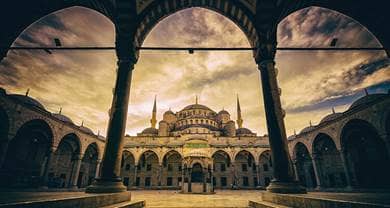- Trending:
- Pope Leo Xiv
- |
- Israel
- |
- Trump
- |
- Social Justice
- |
- Peace
- |
- Love

RELIGION LIBRARY
Sufism
Schisms and Sects
In the first centuries of Sufism, a tariqa was simply a way/path/Sufi school based on the teachings and practice of a particular master, or shaykh . Occasionally, a tariqa is defined as "confraternity" or "brotherhood." In this way, every Sufi tariqa represents a spiritual method for how to practice Islam, not a school of law or a separate orthodoxy. A Muslim is therefore not required to be in any tariqa, though every member of a tariqa is required to be a practicing Muslim.
By the time of the high Middle Ages, more and more people were considering themselves adherents of Sufism and, more specifically, pupils of a particular teacher. A shaykh was often deemed a necessary remedy to the loss of spirituality occasioned by chronological distance from the lifetime of Muhammad . He was the link back to a prophetic past. If Muhammad was no longer present to offer hands-on guidance for a spiritual quest, the shaykh could step in and provide that guidance.
In this way, a shaykh represented the authority of the past and the power to affect the present through his charisma and leadership. Occasionally, the term tariqa is used as a synonym of "silsila," which means chain, and refers to a chain of authority and learning. This legitimacy was passed down from Muhammad to his Companions, to their descendants, and on and on through the generations to the shaykh himself, where it could be continued and extended still further through his students. This concept of a silsila granted Sufis a sense of authenticity in a culture where genealogy, physical and intellectual, mattered.
From the 7th to the 16th centuries, tariqas became organized and more precisely centered on a person and type of practice. Sometimes disciples lived communally, though this was not required. Members of a tariqa apply themselves to extra prayers and the recitation of a wird, a ceremonial set of supplications that is repeated daily and is usually characterized as having been passed down to the founding shaykh from the Prophet. Other types of recitation are ahzab, or litanies, composed by the shaykh of the tariqa, or by one of his early students. Dhikr and group reciting sessions generally called "gatherings" or "majalis" also comprise elements of the practical life of a Sufi. Also rather important for Sufi group worship is the sama'a, a "spiritual hearing" during which poetry is recited, accompanied at times by instruments.
Members of a tariqa could congregate in a designated building, called a zawiya or tekke, though this was not required, as technically these gatherings and practices could take place anywhere. By the 13th century, Sufism became increasingly present in urban settings, and Sufis and their students could be found in mosques of major cities. What characterized a tariqa were the particular instructions a shaykh gave to his disciples: from the recitation of a wird at a particular time to performing an extra prayer one way and not another, certain attitudes toward food, sleep, and so on.










